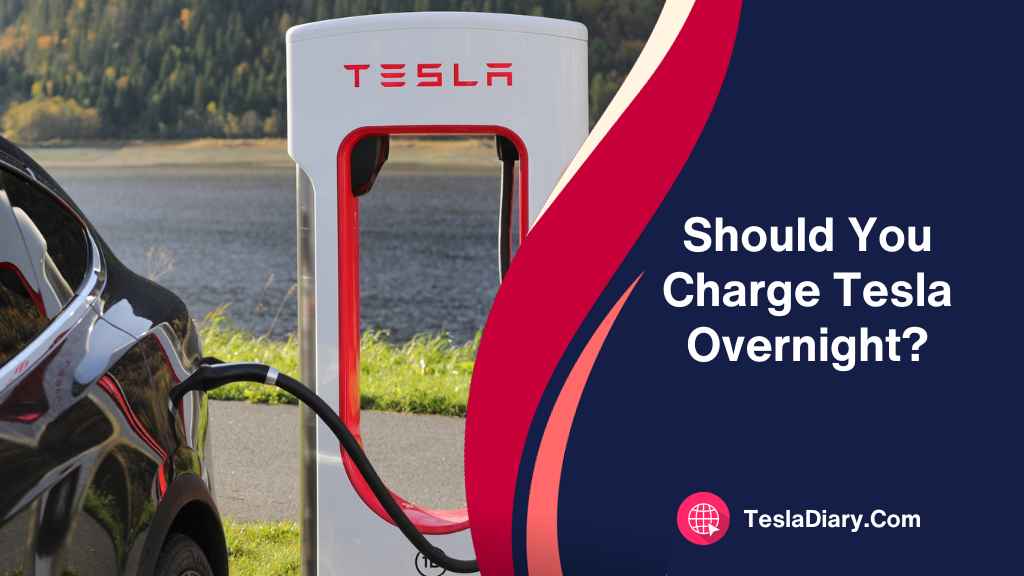In the electrifying world of Tesla ownership, there’s a question that often sparks heated debates and curiosity: Should you charge your Tesla every night?
It’s a question that goes right to the heart of convenience, sustainability, and responsible battery care.
While owning a Tesla is a thrilling experience, understanding the ins and outs of nightly charging is the key to unlocking its full potential.
So, fasten your seatbelts as we dive into the electrifying debate of whether your Tesla should be plugged in overnight!

Tesla’s Recommended Charging Practices
First and foremost, Tesla recommends setting up scheduled charging with a maximum limit of 90%. This ensures that when you plug in your Tesla each evening, it intelligently manages the charging process.
If your battery’s state of charge is below 90%, your Tesla will diligently top it off, bringing it up to that level. However, if your battery is already at 90% or higher, Tesla’s charging system, ever mindful of battery health, will gracefully abstain from passing current through to the batteries.
In other words, Tesla’s charging algorithm is finely tuned to balance your need for a full battery each morning with the preservation of your battery’s long-term health.
It’s a symphony of technology designed to ensure your Tesla is always ready to hit the road while safeguarding the longevity of its power source.
Benefits of Charging Every Night
Charging your Tesla every night may seem like a straightforward routine, but it comes with several advantages that can enhance your ownership experience. Here are some key benefits:
Ensuring a Full Battery in the Morning
One of the most apparent benefits of nightly charging is that it ensures your Tesla starts each day with a full battery.
This means you’re ready to hit the road without worrying about whether your vehicle has enough charge for your daily commute or any unexpected trips that might arise. Starting with a full battery provides peace of mind and convenience.
Maximizing the Convenience of an EV
Electric vehicles, including Teslas, offer unparalleled convenience. There’s no need to visit gas stations, deal with oil changes, or experience the noise and emissions associated with internal combustion engines.
Charging at home every night eliminates the need for time-consuming trips to refuel and allows you to enjoy the effortless experience of owning an EV.
Being Prepared for Unexpected Trips and Emergencies
Life can be unpredictable, and sometimes you may need to travel unexpectedly. Whether it’s a last-minute business trip or a family emergency, having a fully charged Tesla can be a lifesaver.
Electric vehicles, like Teslas, are known for their quick acceleration and responsiveness, making them well-suited for sudden journeys.
Taking Advantage of Lower Electricity Rates During Off-Peak Hours
Many utility companies offer lower electricity rates during off-peak hours, typically late at night. Charging your Tesla during these times can lead to cost savings on your electricity bill.
By adopting a nightly charging routine, you can take advantage of these discounted rates and reduce your overall charging costs.
While these benefits make a compelling case for charging your Tesla every night, it’s essential to address the concerns associated with frequent charging to make an informed decision about your charging habits. In the next section, we’ll explore some of the key concerns related to battery health, energy consumption, and costs.
Concerns About Charging Every Night
While nightly charging offers convenience and peace of mind, it’s not without its concerns. One of the primary concerns is the potential impact on your Tesla’s battery and its long-term health. Here are some key issues to consider:
Battery Degradation and Lifespan
Tesla vehicles, like all EVs, are powered by lithium-ion batteries. Over time, these batteries can experience degradation, which results in reduced capacity and range. Frequent charging and discharging cycles can contribute to this degradation, potentially shortening the lifespan of your Tesla’s battery.
The Role of Lithium-Ion Battery Chemistry
Lithium-ion batteries degrade primarily due to chemical processes that occur during charging and discharging. Each charge cycle causes a small amount of wear and tear on the battery, leading to a gradual decrease in its ability to hold a charge. This degradation is an inherent characteristic of lithium-ion technology.
How Tesla Mitigates Battery Wear
Tesla employs advanced battery management systems (BMS) to minimize battery wear and optimize performance.
The BMS monitors and manages various aspects of the battery, including temperature, voltage, and charging patterns, to ensure the battery operates within safe parameters.
Tesla’s BMS is designed to extend the life of the battery by preventing overcharging and excessive discharging.
While concerns about battery degradation are valid, it’s important to note that Tesla’s engineering and technology work in tandem to mitigate these effects.
Conclusion
In conclusion, adhering to Tesla’s recommendation of charging your vehicle every night, with a maximum limit set at 90%, is not just a routine; it’s a strategic choice based on Tesla’s deep understanding of battery technology.
This approach ensures your Tesla starts each day with a full battery, providing convenience and peace of mind for your daily journeys.
Moreover, it’s a well-thought-out strategy for preserving your battery’s long-term health. Tesla’s charging system intelligently manages the charging process, avoiding unnecessary stress on the battery when it’s already at or above 90% charge.
This delicate balance between convenience and battery care aligns with Tesla’s commitment to providing an optimal ownership experience.
So, whether you’re preparing for a daily commute or an unexpected adventure, rest assured that plugging in your Tesla every night is a data-driven decision that contributes to both your Tesla’s performance and your driving pleasure.
Additional resource

